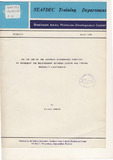| dc.contributor.author | Sommani, Prichar | |
| dc.date.accessioned | 2018-03-07T16:54:40Z | |
| dc.date.available | 2018-03-07T16:54:40Z | |
| dc.date.issued | 1988-03 | |
| dc.identifier.uri | http://hdl.handle.net/20.500.12067/233 | |
| dc.description.abstract | The model is derived under the assumption that within the range of the maximum length and the length at which the fishing mortality is zero, the rate of change in fishing mortality coefficients at ant length is proportional to the product of the fishing mortality coefficients and the reciprocal of the squares of the difference between that length and the length at which the fishing mortality is zero. The resultant leads to the asymmetric sigmoid curve that might be referred to as the Johnson-Schumacher function.
Three data sets of three pelagic species and fourteen data sets of five demersal species were used to estimate the three parameters by the Gauss-Newton method. The results of the estimations and the analyses reveal that in most cases the parameters are well or very well determined in the model and all three parameters and equally important in the model, therefore, none of them can be ignored. All but one case indicate that mor than 95 percent of the variations in the fishing mortality coefficients can be explained by the changes in the fish lengths. Thus, the model can be used to represent the relationships between the fish length and the fishing mortality coefficients very well. | en |
| dc.language.iso | en | en |
| dc.publisher | Training Department, Southeast Asian Fisheries Development Center | en |
| dc.subject | FISHING MORTALITY COEFFICENTS | en |
| dc.subject | JOHNSON – SCHUMACHER FUNCTION | en |
| dc.title | On the Use of the Johnson-Schumacher Function to Represent the Relationship Between Length and Fishing Mortality Coefficients | en |

